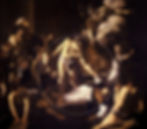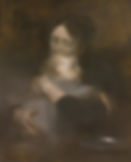Hard Edge Vs. Soft Edge in Classical Oil Painting
- Nic Thurman
- Apr 27, 2023
- 6 min read
Updated: Apr 28, 2023
What Is A Hard Edge Vs. Soft Edge in Classical Oil Painting?
A hard edge vs. soft edge refers to the sharpness or fuzziness of the transition between two adjacent areas. Hard edges are defined and sharp, while soft edges are fuzzy and diffused.

Painting by Frans Hals Vs. Eugene Carriere - Notice the drastically different treatment in edges. The portrait by Frans Hals is a clear example of hard edges while Eugene Carriere has incredibly soft treatment of edges.
Hard Edge
Hard edges are created when two adjacent areas have a clear and distinct boundary. Hard edges can create a sense of solidity and definition, and are often used to emphasize a focal point or to emphasize contours. The real difficultly in balancing edges is strategically placing hard edges.

The Martyrdom Of Saint Matthew by Caravaggio - This painting is an example of using contrast in particular to emphasize certain edges which directs the viewer and emphasizes the focus. This is a great example of using hard edges strategically. While there are many quite clear edges, the focus and central point of the story is still emphasized by using increased contrast and clarity.
Soft Edge
Soft edges, on the other hand, are created when the transition between two areas of color or tone is more gradual and diffused. Soft edges are important to create a sense of depth and atmosphere, and are often used in areas that are meant to recede into the background or to suggest a more atmospheric quality.

Self Portrait By Eugene Carriere - This is an example of the softest edge that can be achieved. The chin and jaw line are completely diffused into the neck and background. This level of softness is difficult to achieve without losing the form and weight of the figure. Here, Carriere has strategically placed subtle tones and sharper contrast in the focus in order to balance this extremely soft edge.
Where to Use Soft Edges
It's important to consider the edges of the forms you are creating, and whether they are hard or soft. Receding areas generally benefit from softer edges, as this helps to create a sense of depth and distance in the painting. Soft edges also help to create a sense of atmosphere and light, as the forms blend together more naturally.
Where to Use Hard Edges
In contrast, areas that are protruding or have a more defined shape may benefit from harder edges. Hard edges help to create a sense of structure and solidity, and can be useful in defining the boundaries between different forms.
Consider The Mood
It's worth noting that edges can also be used to create different moods or emotions in a painting. Soft edges can create a dreamy, romantic feeling, while harder edges can be used strategically to create tension or drama.
What is an edge?
An edge is the outside limit of any object, surface, or area. An edge can be as broad as a mountain against the blue sky, or as small as the black pupil against the blue iris of an eye. The edge is the differentiation on the outer limits where two different objects or surfaces meet or the boundaries that separate one surface or area from another.
In a practical sense, edges are how we distinguish any object from its surroundings. In painting you have the freedom to choose what edges will look like and to manipulate them as you please. For example, one edge that can be removed when painting a portrait is the nasolabial folds or ‘smile line’. By softening or removing these edges entirely, you make your subject look better than they would if you included them. Paint the smile lines hard and your subject will look far older than they do in reality.
How Do You Make A Hard Edge Vs. Soft Edge?
How To Make a Hard Edge
Hard edges are made by the combination of two things: clarity and contrast. Clarity is how well the edge is defined and how finely it is defined. Using a fine line where the difference between one object and another is exact is very clear. Blurring the edges and allowing them to blend together makes them less clear.
Contrast is the difference between color and value of those two objects. If the background is black and the object against it is white, then you will have the highest possible amount of contrast. Combine that with using a fine tip brush to make a line that does not allow for the two objects to blend together at all, and you will have the hardest edge possible.

Notice the difference in clarity and contrast between these two paintings. Has has included many clear outlines and sharp clarity around the head, clothing, and hand. Carriere by contrast has used few clear lines and many of the edges are blending together. The contrast in Hals' painting is extreme around the clothing and pulls the focus away from the face of the figure. Carriere's contrast is much more subtle in the surrounding areas and instead allows the viewer to find a natural resting place on the mother's face.
How To Make a Soft Edge
The converse would create a soft edge. Lack of clarity and lack of contrast creates soft edges. If there is no difference in contrast and the two objects blend together indistinguishably where they meet, you will create the softest edge possible. In that case there will actually be no edge at all. The two objects will be blending together to the extent that there is no noticeable difference between the two.

Painting By Eugene Carriere - One of the ways that Carriere takes advantage of edges is by strongly directing contrast. By reducing the contrast in most of the painting he is able to soften the less important elements and direct us to the focus where there is higher contrast and consequently sharper edges.
Using hard and soft edges like the old masters
As crazy as it may sound, creating these practically nonexistent edges is done quite often by the old masters and helps to create liveliness in a painting. One of the most common tricks for making this work is by creating variation along contour lines.

Self Portrait With Closed Eyes By Odd Nerdrum - Notice all of the variations in different edges throughout this entire painting. In particular, there is an extreme variety within the hair. This helps to create a more lively and dynamic feel to the figure. The blending between the hair and the background makes the edge nearly indistinguishable which leads to a painting that feels like it is moving.
Don't Be Rigid
Defining any contour line in its entirety one particular way, with no variation, will make your painting look stiff and rigid. In the greatest paintings you will be able to find a variation along nearly all edges.
How To Use a Hard Edge Vs. Soft Edge To Your Advantage:
There are multiple considerations for deciding where to place a hard versus soft edge. The main concern should always be the end goal of the painting. Consider the focus. If you want to create a focus on one eye then the edges should help to create that focus. Use higher clarity and higher contrast on that eye and allow for the remaining areas to dissipate increasingly as they approach the outermost limits away from the focus.
Pay attention to what you see while you observe your painting. The goal is to imitate nature, and we automatically see some edges as harder and some as softer.
Typically things that are protruding more will need harder edges, while things that are receding need softer edges. The more drastic the difference is between two surfaces, the harder the edge should be. For example, the nose is usually going to be painted with hard edges because it is so far separated from the surrounding parts of the face. The eyes are also going to have harder edges compared to smoother parts of the face.
If two surfaces are very distinct then they will usually need to have a hard edge. You can also use the way that we perceive these edges to create more liveliness. By blending sharp and soft edges on a single contour your portrait will feel more alive.
Why do edges matter in oil painting?
Our eyes capture a focus in a particular way. We never see our entire view with complete clarity. For example, think about your peripheral vision. The majority of what you are able to see is actually blurry, while one small area you focus on becomes more sharp.
To make a painting where everything is in focus, painted with complete clarity and equal contrast, would be to paint the world as we do not see it. It would be disturbing and would leave the viewer overwhelmed with no focus to settle on.
By choosing where to place a focus and balancing your edges you are able to imitate life and choose where the viewer should focus. In addition it will make the painting look much more alive. Overall, the balance and harmony of hard and soft edges to imitate the way that we naturally see the world, will result in the most satisfying painting for viewers.
Want To Learn More About Classical Oil Painting?
Are you passionate about classical oil painting and want to take your skills to the next level? Join our Patreon community at patreon.com/nicthurman to learn more in depth about classical oil painting techniques and the craft of oil painting. With exclusive access to in-depth tutorials, painting philosophy, and personalized feedback, you'll be able to develop your skills and create more lifelike paintings. Don't miss out on this opportunity to master the craft. Join us on Patreon today!